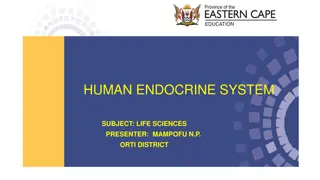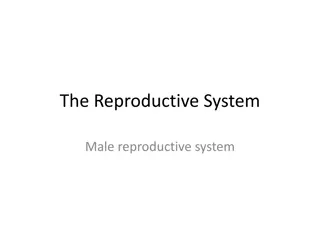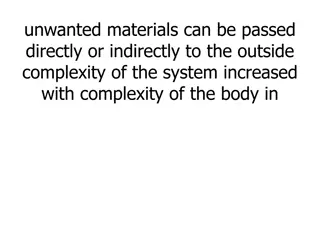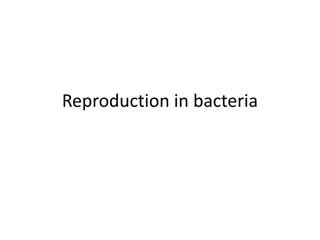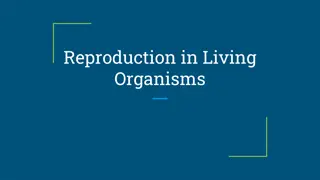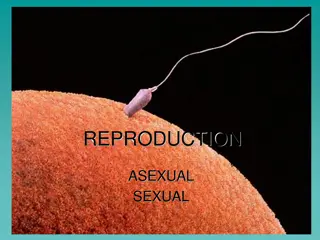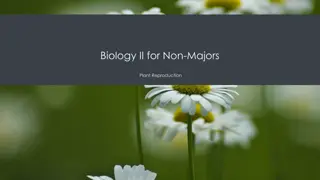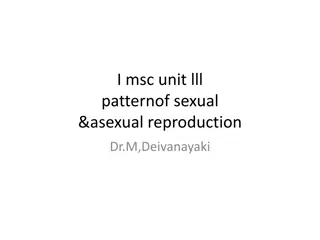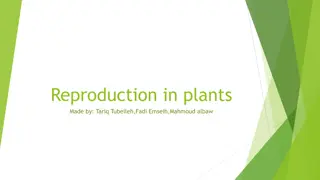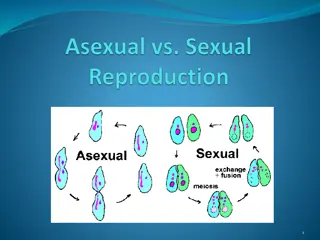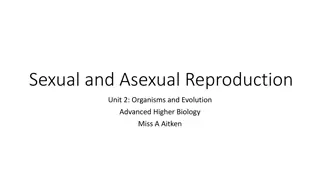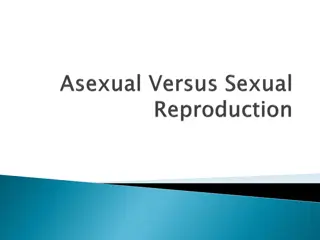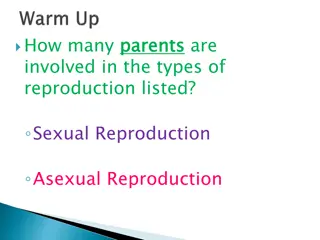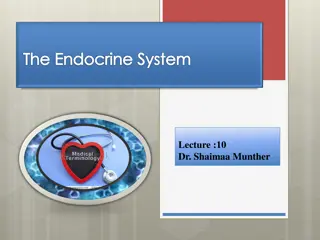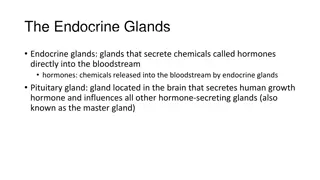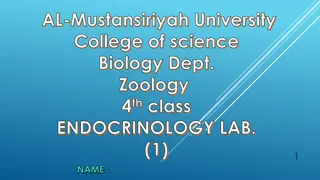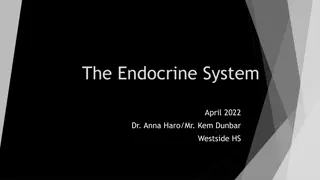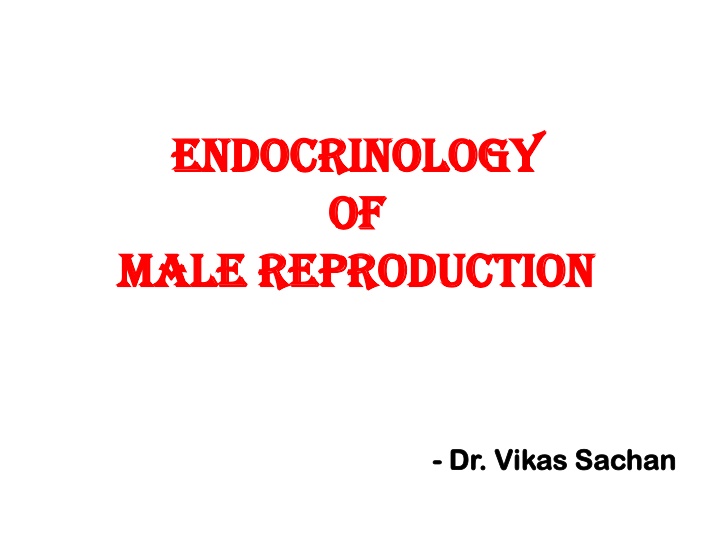
Male Reproductive Endocrinology
Explore the intricate endocrine system governing male reproduction, from the role of pituitary gonadotrophins and gonadal androgens to the feedback mechanisms and hormonal interplay in regulating testosterone levels. Delve into the functions of the hypothalamus, Leydig cells, and key reproductive hormones like GnRH, LH, FSH, and testosterone.
Download Presentation

Please find below an Image/Link to download the presentation.
The content on the website is provided AS IS for your information and personal use only. It may not be sold, licensed, or shared on other websites without obtaining consent from the author. If you encounter any issues during the download, it is possible that the publisher has removed the file from their server.
You are allowed to download the files provided on this website for personal or commercial use, subject to the condition that they are used lawfully. All files are the property of their respective owners.
The content on the website is provided AS IS for your information and personal use only. It may not be sold, licensed, or shared on other websites without obtaining consent from the author.
E N D
Presentation Transcript
ENDOCRINOLOGY ENDOCRINOLOGY of of MALE REPRODUCTION MALE REPRODUCTION - - Dr. Dr. Vikas Vikas Sachan Sachan
ENDOCRINOLOGY OF THE MALE REPRODUCTION ENDOCRINOLOGY OF THE MALE REPRODUCTION - Controlled by - Pituitary gonadotrophins Gonadal androgens - Only negative feedback mechanism (Unlike in female) i.e. Synchrony b/w pituitary gonadotrophins with gonads in male is non cyclic - After castration Retained pulse frequency of LH and FSH
- Hypothalamus - Interface between - Nervous and endocrine system - GnRH synthesized in neurons in hypothalamus, released at nerve endings (episodic) transferred via hypophyseal portal system ..Anterior pituitary Gonadotrophins
- Sex Hormones are sex specific e.g. Estrogen and progesterone - Female Testosterone - Males - Sex specificity is limited
- LH receptors on leydig cells in bulls (Upto 6-7 months of age) - Less in no. and less sensitive - No stimulus for testosterone - Growth hormone, Insulin, IGF-1 stimulatory effect of LH on its receptors - LH receptors - leydig cells, germ cells - Testosterone receptors - On the leydig cells, Sertoli cells (but not on the germ cells) Myoid cells
- Male reproduction is mainly controlled by - Hypothalamic GnRH - Pituitary Gn; LH & FSH LH in pulsatile fashion (15-30 ng/ml .. 2-4 hr) LH receptors Gonadal leydig cells Androgens (Testosterone) (After 30-60 minutes of LH peak (10-20 ng/ml) - Basal again after 40-80 minutes
- In bulls LH ; 5 ng/ml to 15-30 ng/ml Testosterone 2-8 ng/ml to 10-20 ng/ml -In dogs LH ; 1.0-1.2 ng/ml to 3.8-10.0 ng/ml Testosterone 0.5-1.5 ng/ml to 3.5 -6.0 ng/ml - In tom LH ranges from 3 to 29 ng/ml Testosterone ranges from 0.1 to 3.3 ng/ml
- Acting on the Leydig cells ..LH regulates steroidogenesis (leydig cells) Cholesterol rate limiting step (Control by LH) Pregnenolone Progesterone Testosterone (18 C)
Androgen (testosterone) 5 - reductase enzyme aromatase sertoli cells DHT estradiol (5 - dihydrotestosterone) - Sertoli cell tumor - High level of blood estrogen (mainly in canines) -Testosterone in the blood Bound -globulin (Maximum) Free which is converted into DHT
- Maximum estrogen.from testosterone - Epididymis of stallion - DHT and estradiol -ve feed back response - at the level of hypothalamus and pituitary - DHT is more potent androgen than testosterone - DHT - controls accessory sex gland activity - Testosterone - spermatogenesis.
- Androgen-binding protein (ABP) - Bind testosterone and DHT - High androgen concentrations in S.T. & Epid. - FSH - Non episodic pattern - Proliferation i.e. determine the sertoli cell numbers at puberty .... Limit postpubertal spermatogenic yield
- FSH is - Initiation of spermatogenesis - FSH and testosterone - Maintain spermatogesis - Spermiation - FSH Functions / secretion of sertoli cells : 1. Androgen binding protein (ABP) Steroid binding protein - -globulin 2. Activin Development of leydig cells - Delay growth of leyd. cells till puberty - Secretion of FSH at pituitary level
3. Inhibin - Differentiating and growth factor - Regulates leydig cell function - Negative feedback effect on the FSH - Inhibin B is more potent 4. Anti-mullerian hormone (AMH / MIH) - Inhibit mullerian duct system - Development of male fetus 5. Transferrin Source of iron for sperm 6. Glutathion Acts as anti-oxidant 7. Insulin like growth factor 8. Nursing / Sustentacular cells Sperm nursing
- Prolactin - Prolactin receptors - On leydig cells - Promotes the functions of LH receptor - High level of prolactin, growth hormone (GH/STH) and melatonin - Negative feedback for Gn - Delayed sexual characters - Delayed sexual behavior - Delayed puberty and libido
- Functions of androgen : 1. Testicular descend 2. Sexual differentiation of male reproductive system 3. Regulation of structure and function of accessory sex glands and ductus system 4. Spermatogenesis
5. Development of secondary sexual characters and maleness (Body confirmation, hairs, hump, broad shoulder, aggressiveness, muscle growth etc) 6. Pronlongation of epididymal sperm life 7. Different sexual behavior pattern in diff sp. 8. Penile and prepucial growth 9. Degeneration of penile frenulum 10. Urinary pattern in dogs
- Prepubertal castration - No libido - Underdeveloped genitalia - No mating behavior - Post pubertal castration - leads to stoppage of ejaculation - Mounting behavior - Penile erection - High Testosterone - hypertrophy and hyperplasia of prostate
- Thyroid stimulating hormone (TSH) Growth hormone (STH) Adrenocorticotrophic hormone Melatonin . Maintenance of male reproduction - Over secretion - Negative feedback effect
- Oxytocin - Increasing tubal activity at ejaculation - Increased seminal volume - More sperm concentration - -endorphin (endogenous opioid peptides) - Present in testicular interstitial fluid - Leydig cell steroidogenesis.
- Stallions and rams - Seasonal breeders - Stallion long day breeder - Ram and camel - short day breeder - Stallion ......More light (short night) Less melatonin (from pineal gland) ..More gonadotrophins ..More steroids (androgens) - Long days after short days .a rhythm - Necessary for stallion reproduction
- Reducing the day light hours in ram - Increased melatonin - Reduced prolactin production - Increased gonadotrophins secretion - Increased testosterone - In non-breeding season - Not azoospermic completely
THERMOREGULATION OF TESTES THERMOREGULATION OF TESTES - Optimim sperm production or spermatogenesis ..requires 20-50 C less temperature - Structures play role in thermoregulation - 1. Thermoreceptors - On scrotal skin - Body sweating / panting 2. Adrenergic sweat glands - On scrotal skin
3. Absence of subcutaneous fat in scrotal skin 4. Contraction & relaxation of tunica dartos 5. Contraction & relaxation of Cremaster muscle 6. Testicular artery and vein (Pmpiniform plexus) - Heat transfer
- In boar - Less pendulous scrotum - Less efficient sweating - Difference of about 3.20 C - In ram - temperature difference between spermatic artery and vein is about 40 C.



